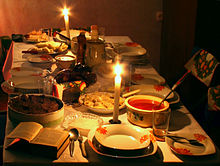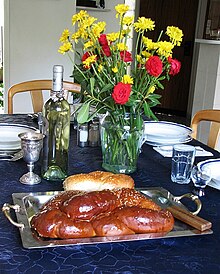Wigilia
Wigilia (from Latin vigilare , "to watch") is the Polish celebration on Christmas Eve with the traditional 12-course menu. The family is a small church. Hence prayer and worship also have a place in it. On Christmas Eve, Poles combine the family celebration with a domestic liturgy: They pray and watch until the arrival of the Baby Jesus with the traditional 12-course buffet in the family circle from around 6 p.m. to the shepherd's mass (Polish: Pasterka ), according to the course of the Celebration of Christmas Eve, as it is now also proposed by the (arch) bishops of Germany and Austria and the bishop of Bozen-Brixen in the new German praise of God (GL 26). It includes songs, prayers, the gospel of the birth of the Lord and the Christmas signs and symbols. The nativity scene is the focus of this celebration, because it shows us: The Son of God became human like us. For Poland, the Wigilia is the most important family festival of the year.
Extended meaning of wigilia
The term Wigilia is used colloquially for the whole of December 24th. Then the term “wieczerza” (or “wieczerza wigilijna”) is used for the actual 12-course meal. The last supper is called accordingly in Polish: "ostatnia wieczerza".
Postponement from December 24th
The Christmas Eve celebrations have also been postponed. It is traditional to fast during the day on Christmas Eve. According to popular tradition (which is still alive in the Kielce region, for example ), in the years when December 24th fell on a Sunday, Christmas Eve was not allowed because fasting was not allowed on Sunday. In this case, Christmas Eve was moved up to Saturday and Christmas was celebrated for three days.
Traditions and Customs

Christmas customs in Poland can also be traced back to folk customs that are fused with Christian traditions. Usually children decorate the Christmas tree ( choinka ) on this day if it has not already been set up. The first Christmas trees in Polish families were in the 19th century, mostly in cities with many Germans. Before that, Polish families decorated their apartments with pine, spruce or fir branches.
Often some hay is placed under the tablecloth or in the four corners of the room. This symbolizes that Jesus was born in a stable . In the country, too, people ask for a good harvest next year. Many Polish families also put coins under their plates or tablecloths to protect family members from poverty. The same purpose is pursued with a fish bone or a fish scale that is put in the purse after eating.
As a game, children pull out some of the hay that is under the table. Green means a year of prosperity or possibly marriage while black hay means bad luck. A number of other oracles are practiced a little more seriously. For example, a nut (or other small piece of food) is hidden in a cake and then the pieces of cake are given to the family members. Those who find the nut in their piece will have a successful year.

There is a white tablecloth and an additional place setting on the table. This reminds of deceased family members. But it is also there for an “unexpected guest” in the event that a traveler, family member or friend knocks on the door and can then celebrate right away. This also relates directly to the Christmas story when Mary and Joseph looked for shelter but were not taken anywhere until they were accommodated in the Bethlehem stable . An old Polish proverb says: “Gość w domu, Bόg w domu” (“If there is a guest in the house, then God is in the house”).
In the country it is tradition that costumed carolers go from house to house, with a crib or a star. These improvise important Bible scenes. Among other things, angels, devils, Herod and death are represented. In the past, the singers were usually given a treat for this, whereas today they are usually given some money. In popular belief, it is assumed that the course of the Wigilia has an influence on the following year. So when a family quarrel arises, it is believed that it will herald a contentious and arduous year. Therefore, on this day, the family members meet in a conciliatory manner and celebrate the bond and love for one another.
Start of the celebrations
The celebration traditionally begins as soon as the evening star has been spotted in the sky at dusk (usually by children at around 5 p.m.). Therefore, Christmas is sometimes called Gwiazdka in Poland , because Gwiazdka brings the presents and literally means "the little star". This refers to the star of Bethlehem .
Breaking the Christmas wafer
Family members begin the celebration with a prayer. Then a Christmas wafer (it resembles a host in consistency ) is broken into pieces and distributed to the various family members. Then each family member breaks something from the Christmas wafer of every other person present and thus shares his wafer piece with the other family members as a sign of love, reconciliation, friendship and peace, wishing each other good luck and joy for the next year, as Christ was born. The baby Jesus, the Virgin Mary and angels are usually embossed in the Christmas wafers. These wafers are also sent to friends and relatives around the world to share in this tradition. After that, you often kiss yourself on the cheek. Breaking the Christmas wafer, which symbolizes bread, refers to the ancient Christian tradition of breaking bread . In religious families, the story of the birth of Jesus is read from the Bible.
In the countryside, livestock also get something from the Christmas wafer, because on this day the cattle are treated in the same way as all members of the household, according to a legendary tradition that on Christmas night animals can speak with a human voice, but only people who pure of heart, they could hear them too. However, the wafers fed to the cattle must be colored, unlike the white wafers that people break together.
After the evening star rises and after praying, sharing the Christmas wafer and reading the story of the birth of Jesus, dinner begins after fasting all day.
The dinner

Twelve dishes are traditionally served, symbolizing the number of months in a year as well as honoring the twelve apostles of Christ. However, some families cook fewer dishes, either seven, nine or eleven. Ideally, every dish is tasted in order to honor the fruits of the earth and the dishes made from them.
Traditionally, a Wigilia meal does not include meat, but rather the following dishes: Barszcz beetroot soup with uszka (ravioli), pierogi with sauerkraut and mushrooms ( pierogi z kapustą i grzybami ).
To Wigilia traditionally includes a fish dish: pickled herring , Matjes ( herring ) ( Śledzie ) or fried fish. Since 1940 the carp in the form of the gefilten fish ( karp po żydowsku ) has developed from the Jewish tradition into a popular fish for the Wigilia . It was mostly bought alive because it was assumed, especially under socialism , that the fish was really fresh. Then it was kept in the bathtub until Christmas, and then served as a fillet or in jelly, etc.
This includes a Christmas pie ( pasztet wigilijny ). Likewise, a challah ( chałka ) , borrowed from the Jewish tradition, is often eaten as bread on Shabbat . This is followed by kompot z suszu - compote made from dried fruit (plums, apples, apricots, etc.), boiled potatoes ( kartofle ), red cabbage with dried fruit, sauerkraut with dried mushrooms or peas ( kapusta i groch ) and desserts such as kutja (eastern Poland), makówki (Silesia), Makiełki (Central Poland) or Makowiec (poppy seed rolls). Regionurek , Siemieniotka (in Silesia), mushroom soup , various salads or cabbage rolls ( Gołąbki ) filled with mushrooms and rice vary from region to region .
Sing Christmas carols and open presents
After dinner, many families sing Christmas carols (“kolędy”) and stories are told. One of the most famous Christmas carols is “Lulajże Jezuniu” ( Sleep in, Baby Jesus ), which Fryderyk Chopin wrote in his Scherzo in B minor Op. 20 (from 3:50).
Girls listen to see if they hear a dog barking because it is believed that this is where their future husband will come too.
The Wigilia celebrations also include opening the presents after dinner. The children often unwrap their presents themselves and give the adults the presents that are under the Christmas tree for them.
The gift givers in the Polish tradition are "aniołek", an angel, the Christ Child (dzieciątko; in Silesia) "gwiazdka" (in southern Poland, Lower Silesia, Opole), a star - the female counterpart of St. Nicholas - or the gwiazdor (male; in Poznan), which is either a pagan tradition or represents the little star of Bethlehem. Saint Nicholas, on the other hand, brings gifts on December 6th.
Pasterka - the shepherds' mass
On Christmas Eve, after Wigilia, there is often an evening mass at 10 p.m., before the one-hour Roman Catholic holy mass begins at midnight : the Pasterka (shepherd's mass ). In Poland, this is the most important of the three Christmas Day fairs. Many Christmas carols are sung, including the Polish Christmas hymn Bóg się rodzi (God is born). The Pasterka is the culmination of December 24th for Polish, practicing Catholic Christians.
The Christmas breakfast
After Christmas Eve ( Wigilia ) there are two more days of Christmas celebrations. Boxing Day (December 25th) is a national holiday in Poland and most Poles spend the day celebrating with their families. The Christmas breakfast on Christmas Day often consists of scrambled eggs , cold cuts , smoked or fried salmon with horseradish sauce , salads, coffee , tea and cakes such as poppy seed rolls , piernik (gingerbread), biscuits or kutja.
Individual evidence
- ↑ a b c d e f g h i j k l Christmas in Poland, Polish Christmas on Info-Polen.com . In: info-polen.com .
- ↑ a b c d e f g h i j Wigilia . In: austriapol.com .
- ↑ a b c d e f g h i j k l Wigilia on de.poland.gov.pl (German) . In: poland.gov.pl .
- ↑ a b c d e f g h i j k Wigilia . In: polishamericancenter.org .
- ↑ a b c d e f g h i j k Wigilia on www.polishcenter.org (English) ( Memento of the original from November 27, 2010 in the Internet Archive ) Info: The archive link was inserted automatically and has not yet been checked. Please check the original and archive link according to the instructions and then remove this notice.




